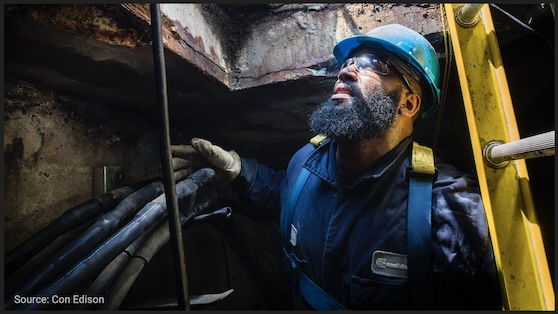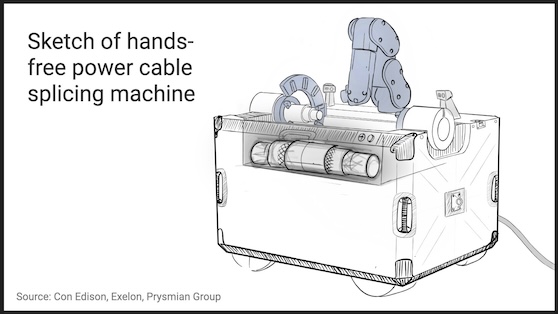
Articles
Features
News
News
Articles
Energy & Power
Transmission & Distribution
Prysmian scores $4.5M in funding to develop grid “undergrounding” machine
February 27, 2024 | By Anthony Capkun
 Con Edison employee works underground on cable repairs.
Con Edison employee works underground on cable repairs. February 27, 2024 – Prysmian Group reports it has been selected to receive $4.5 million in funding from the U.S. Department of Energy—Advanced Research Projects Agency-Energy (ARPA-E)—for technology to modernize the grid.
The funding is part of the “Grid overhaul with proactive, high-speed undergrounding for reliability, resilience, and security” (a.k.a. GOPHURRS) program, which aims to strengthen and modernize the country’s aging power grid.
“We know that, by undergrounding our grid, we can create a more resilient and reliable U.S. power grid,” said Dr. Evelyn N. Wang, director, ARPA-E.
According to GOPHURRS, over 90% of powerline failures happen on the MV distribution grid; in the U.S., this system comprises over 5.5 million line-miles and over 180 million power poles. These are all susceptible to damage by weather and tree-related incidents, which account for 62% of all power outages every year.
“Undergrounding powerlines is a proven way of improving the system reliability for both transmission and distribution grids, as weather events are less likely to interfere with systems that are protected below ground,” say GOPHURRS proponents. However:
Despite the reliability, resilience, and security benefits, today’s methods of undergrounding powerlines are disruptive to surface and environments, slow in construction, unsafe for workers, and consequently make an undergrounding project too expensive to afford.
The GOPHURRS program aims to tackle these problems head-on, added Wang, “by developing new technology solutions that allow for reducing costs, increasing speed, and improving the reliability and safety of undergrounding the grid”.
To that end, GOPHURRS seeks to simplify the construction of underground medium-voltage (5-kV to 46-kV) grids in urban and suburban areas by adopting a concurrent drilling and conduit installation method of construction that reduces inefficiencies.
Projects, therefore, will focus on “advancing transformative autonomous utility installation technologies, such as automated and rapid subsurface drilling along the terrain and concurrent conduit installation, while also avoiding hidden underground obstacles with advanced look-ahead sensors”.

With its funding, Prysmian intends to develop a hands-free power cable splicing machine to operate in underground vaults, with the goal of reducing the share of splicing-caused medium-voltage network failures from 60%-80% to less than 5%, and “dramatically improve workforce safety by reducing the time the underground cable splicing crews spend in underground vaults”.
Prysmian’s development of the machine is being done in collaboration with Con Edison and Exelon, two investor-owned utilities in the U.S.
“Safety is a top priority for Con Edison,” said Patrick McHugh, senior VP, Operations. “That’s why we are proud to partner with Prysmian, Exelon, and the DoE to develop a tool that will improve worker safety, efficiency, accuracy and, ultimately, the reliability of the nation’s grid.”
Other GOPHURRS participants and projects include:
• Arcbyt – Integrated thermal spallation drill for heterogeneous ground conditions
• Arizona State University – High-speed installation of buried medium-voltage electrical distribution lines using a single-pass system
• Case Western Reserve University – Peristaltic conduit with stiff structure and compliant skin
• Cornell University – Mini-Mole: Combustion-powered tip fracturing and undulatory locomotion robot
• GE Vernova Advanced Research – SPEEDWORM: Swift, portable, and efficient electrical undergrounding using a water-free, compact, and reliable machine
• Melni Technologies – Enhancing reliability and resilience of underground distribution systems using innovative splicing
• Oceanit – Artificial intelligence and unmanned aerial vehicle real-time advanced look-ahead subsurface sensor (AURALSS)
• Pacific Northwest National Laboratory – Subsurface intelligence for undergrounding operations; rapid AI-based geophysical imaging and advanced visualization
• RTX Technology Research Center – UnIQue: Underground imaging with quantum sensors
• Sandia National Laboratories – Advancing horizontal directional drilling for rapid undergrounding of electrical utilities
• Virginia Polytechnic Institute and State University – Multi-physics, intelligent sensing system (MISS) for real-time, look-ahead while drilling
“Exelon is committed to being a leader in the energy transformation, and this means nurturing a culture of continuous innovation,” said Sunny Elebua, senior VP and Chief Strategy & Sustainability Officer.
Print this page